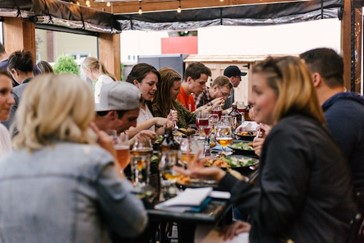
Alberto Araya of Gainesville enjoys trying new, and exciting dining options in his local area. In the following article, Alberto Araya discusses trending and innovative restaurant concepts to look for in the coming years.
After over three years of struggling to stay afloat, the restaurant industry continues to be assailed with challenges from supply chain woes to staffing issues to evolving customer expectations. Add real estate issues, inflation, and technological changes to that recipe, and it’s a wonder that the industry has any energy left for innovation.
But restaurants have always been resilient, and they continue to adapt to changes and develop bold ways to keep serving customers. From redesigning restaurant interiors to meeting conflicting desires for fast casual food and eclectic or local ingredients, the industry has continued to weather the storm. New technology has both helped and hindered survival and growth. Now, more than ever, we’re seeing innovative concepts designed to keep customers coming in to dine.
Below, Alberto Araya of Gainesville takes a look at several unique ideas changing the dining experience.
Alberto Araya on Fast Casual Plus Restaurants
Time is money. But what can a restaurant do when everyone is short on both? By no means is fine dining a thing of the past, but more and more diners are looking to eat and run – whether it’s professionals on a lunch break or groups of friends who no longer have time for extended get togethers in their busy lives.
Enter fast casual (plus) dining concepts. These restaurants lure patrons who don’t want the fast-food experience but do want their food fast. Incorporating digital technology is one tactic they use to streamline the ordering process to save money on staff, add personalized options, and reinvest in the surroundings that make going out to eat an occasion.
Indigenous Ingredients and Local Foods
Alberto Araya of Gainesville says that for those looking for a more authentic dining experience, restaurants are increasingly using locally sourced and native ingredients. Not only does this bring something new to the table and boost the local economy, but it helps promote more sustainable dining practices and lessens reliance on global supply chains.
Some restaurants are also creating storytelling experiences around the local, native culinary culture and heritage to deepen the dining experience for customers.
Flexible and Adaptable Menus
Local food sources bring about another necessary change that can keep customers coming back – flexible menus. As restaurants diversify their supplier lists and use seasonally available ingredients to adapt to supply chain disruptions, they can offer patrons a changing variety of dishes and more exciting menus.
Alberto Araya of Gainesville explains that this also streamlines operations and reduces waste for restaurants. And again, digital technology plays a role in this update by allowing restaurant owners to easily update digital menus and inform customers about available dishes via social media. It can also influence creativity in the kitchen, as chefs are challenged to come up with innovative recipes based on available ingredients, which often leads to smaller and more streamlined menus.
Communal Dining
Alberto Araya notes that restaurants have long been evolving into more social spaces. The trend of communal dining sees a return to large, shared tables, encouraging social interaction among patrons. Socially, it offers a counterpoint to the increasing digitalization of human interaction and a reprieve from the isolation of pandemic dining.
Restaurants are incorporating live music performances, open-mic nights, and locally curated art displays to engage patrons. This trend is also seen in multi-restaurant spaces or food halls, where different vendors share a large communal dining area.
 Digital Dining Experiences
Digital Dining Experiences
While technology is fostering change on the restaurant floor and in the kitchen, digital dining experiences for customers themselves are perhaps one of the most radical transformations we’ll see in the near future.
Alberto Araya of Gainesville says that while technologies like augmented reality (AR) and virtual reality (VR) have long been touted as game changers (and VR is likely a trend that will emerge further into the future), restaurants are increasingly finding ways for patrons to interact with their food, its history, and its beauty. This goes far beyond optimizing spaces for food photography to make dining “Instagrammable” and portends a different type of engagement.
For example, these enhanced experiences can increasingly offer interactive menu browsing, virtual kitchen tours, personalized cooking experiences where diners can participate in the preparation of their meals, and immersive dining experiences that transport customers to the vineyard where their wine was produced.
Summary
Alberto Araya says that the restaurant industry is still recovering from the height of the pandemic while simultaneously struggling with the long-term changes it wrought. Like anything, it will need to adapt to survive. While customer needs and expectations are changing the nature of some dining options, technological advances are pushing the boundaries of what restaurants offer their customers. But there will always be something for everyone – from faster food to slower and more immersive sensory experiences that excite chefs and connoisseurs alike.


